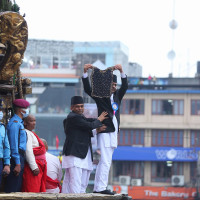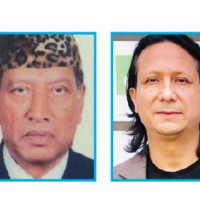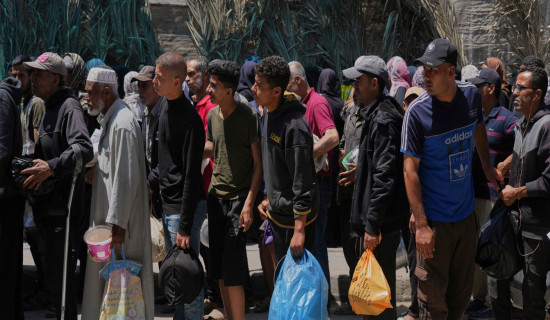- Sunday, 1 June 2025
Charumati Bouddha Vihar: A Place Of Peace
In my pious tour to Nepal in 2023, I visited Charumati Bouddha Vihar of Kathmandu, which is situated at Chabahil. Here, I met the Vajracharya priest, the monk in charge of the Vihar. Since I love Nepal, I have deep regards for the country's religions because all the religions known to us have their significant features here in Nepal. As such, both Hinduism and Buddhism, with the passage of time, become enriched by various famous religious leaders. One such female religious leader who was actually a monk queen was princess Charumati, daughter of the Mauryan Monk Monarch, Emperor Ashoka.
Being a Hindu King of India, Asoka converted himself to Buddhism under the gracious guidance of the Bouddha monk, Upagupta. Asoka's conversion to Buddhism therefore may be dated in BC 261-260. While in Hinduism, Dharma implies the rule of life for each man as determined by his caste and station, or, in other words, the whole duty of a man, i.e., religious, moral, and social, was born to occupy a certain position in the world.
In Buddhism, Dhamma means the law of peity and the law of duty. This concept of Dhamma was disseminated by Emperor Ashoka in the post-Kalinga war period.
After the conquest of the Kalinga war, Ashoka used to wear the monks' robes and began his journey to Lumbini. From Rupandehi and Niglihawa pillars in Terai of Nepal, we come to know that in BC 249 Ashoka visited Lumbini and donated gold coins to erect a Bouddha Stupa in Lumbini. After the birth of Ashoka, one Bouddha Bhikkhu predicted that one day Ashoka would win the hearts and minds of people around the world. From a simple layman of Buddhism, Ashoka elevated himself to the height of a sincere Buddhist monk in theory and in practice. Eventually Ashoka arranged his daughter Charumati's marriage with a Kshatriya from Nepal, named Debopala. Charumati, after her marriage, started to believe and practice Buddhism in her daily life, which is intermingled with the lifestyle of Debopala.
Like King Ashoka, Charumati was the princess with eminent qualities. She was active, laborious, and vigilant. She used to manage all her affairs herself and dispatch them with wonderful readiness. Like King Ashoka, she used to put out edicts of Ahimsa. i.e., forbidding to kill oxen or sheep even for the sacrifices and appointing ground corn to be offered instead of beasts.
As I visited the Charumati Vihar of Kathmandu, Vajracharya of the Vihar told me that each man is responsible for himself; each man is a maker of himself. Only he can do himself good by good thoughts and good acts. This doctrine of Dhamma was practiced and obeyed by Charumati, daughter of Ashoka.
Queen Charumati, however, cared not so much for gifts but for the growth of respect for all sects. There is no almsgiving as is the almsgiving of the Law of Piety, liberality in piety, kinship in piety. She always followed the instructions of her father, King Ashoka, that respect to Father and mother, liberality to friends, acquaintances, relatives, Brahmans, and ascetics, excellent is abstention from the slaughter of the living creatures, small expenses with small accumulation Queen Charumati also made healing arrangements for both men and the beasts. She planted and imported medicinal herbs both for the men and for the beasts when they were lacking.
On the roads, she dug wells and planted trees, following Emperor Ashoka's teachings. Following Charumati's footsteps, the Queens of Nepal also adopted the Dhamma doctrines of Buddhism in their lifestyles. Why Charumati Bouddha Vihar is still a place of attraction is a big question. The answer is that through this Vihar, we can strengthen not only Nepal-India relations but also the global connectivity with Nepal.
Today, we, the people of India, should maintain a good relationship with the people of the land of Lord Pashupatinath to be the masters of regional peace. Nepal is the birthplace of Gautam Buddha, the global icon for peace and enlightenment.
This legacy contributes to building and promoting peace in any society and creating an environment conducive to non-violence. This promotes mutual help and paves the way to a broader development of humankind. 'Nepali people believe that peace does not merely mean absence of war but encompasses the well-being and happiness of humankind with nature friendly activities. Nepal believes that there should be peace everywhere in this world. We want to feel peace in our neighbouring countries,' the Vajracharya of Charumati Vihar told me.
Buddhism is continued as a tool for cultural exchange in the modern age. The role of Buddhism in international relations in the Asian context is very crucial even today. There is a misunderstanding about Buddhism that it is an apolitical thing. Transnational Buddhist networks are made towards diplomacy, proposing a framework of Asian cultural and diplomatic relations that go beyond migration and migratory flows. Thus, Charumati Vihar presently is a bridge of peacebuilding. The legacy of non-violence and mutual respect is the life of Asian diplomacy. It is a must-visit destination for all.
(The author is an Indian journalist.)

















